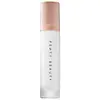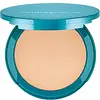Fenty Beauty Pro Filt'r Mattifying Primer Versus Colorescience Natural Finish Pressed Foundation SPF 20
What's inside
What's inside
 Key Ingredients
Key Ingredients

 Benefits
Benefits

 Concerns
Concerns

 Ingredients Side-by-side
Ingredients Side-by-side

Water
Skin ConditioningDimethicone
EmollientIsononyl Isononanoate
EmollientPolypropylene
Cetyl PEG/PPG-10/1 Dimethicone
EmulsifyingPentylene Glycol
Skin ConditioningIsododecane
EmollientNylon-12
Polymethyl Methacrylate
Hdi/Trimethylol Hexyllactone Crosspolymer
Maltose
MaskingPhenoxyethanol
PreservativeSodium Chloride
MaskingDimethicone/Vinyl Dimethicone Crosspolymer
Skin ConditioningMagnesium Sulfate
Ethylhexylglycerin
Skin ConditioningDisteardimonium Hectorite
StabilisingAgave Tequilana Leaf Extract
AstringentDimethiconol
EmollientSilica
AbrasivePropylene Carbonate
SolventParfum
MaskingBiosaccharide Gum-4
Skin ConditioningTocopherol
AntioxidantWater, Dimethicone, Isononyl Isononanoate, Polypropylene, Cetyl PEG/PPG-10/1 Dimethicone, Pentylene Glycol, Isododecane, Nylon-12, Polymethyl Methacrylate, Hdi/Trimethylol Hexyllactone Crosspolymer, Maltose, Phenoxyethanol, Sodium Chloride, Dimethicone/Vinyl Dimethicone Crosspolymer, Magnesium Sulfate, Ethylhexylglycerin, Disteardimonium Hectorite, Agave Tequilana Leaf Extract, Dimethiconol, Silica, Propylene Carbonate, Parfum, Biosaccharide Gum-4, Tocopherol
Titanium Dioxide 21.2%
Cosmetic ColorantZinc Oxide 12.1%
Cosmetic ColorantMica
Cosmetic ColorantEthylhexyl Hydroxystearate Benzoate
EmollientTocopheryl Acetate
AntioxidantDaucus Carota Sativa Seed Oil
EmollientGlycerin
HumectantMethicone
EmollientDimethicone
EmollientTriethoxycaprylylsilane
Lycopodium Clavatum Extract
Skin ConditioningImperata Cylindrica Root Extract
Skin ConditioningLauroyl Lysine
Skin ConditioningSilica
AbrasivePelargonium Graveolens Flower Oil
MaskingCananga Odorata Flower Oil
MaskingFusanus Spicatus Wood Oil
MaskingPhenethyl Alcohol
MaskingSodium Dehydroacetate
PreservativeCaprylyl Glycol
EmollientPhenoxyethanol
PreservativePotassium Sorbate
PreservativeBenzyl Benzoate
AntimicrobialFarnesol
PerfumingLinalool
PerfumingCI 77163
Cosmetic ColorantCI 77288
Cosmetic ColorantCI 77491
Cosmetic ColorantCI 77492
Cosmetic ColorantCI 77499
Cosmetic ColorantTitanium Dioxide 21.2%, Zinc Oxide 12.1%, Mica, Ethylhexyl Hydroxystearate Benzoate, Tocopheryl Acetate, Daucus Carota Sativa Seed Oil, Glycerin, Methicone, Dimethicone, Triethoxycaprylylsilane, Lycopodium Clavatum Extract, Imperata Cylindrica Root Extract, Lauroyl Lysine, Silica, Pelargonium Graveolens Flower Oil, Cananga Odorata Flower Oil, Fusanus Spicatus Wood Oil, Phenethyl Alcohol, Sodium Dehydroacetate, Caprylyl Glycol, Phenoxyethanol, Potassium Sorbate, Benzyl Benzoate, Farnesol, Linalool, CI 77163, CI 77288, CI 77491, CI 77492, CI 77499
 Reviews
Reviews

Ingredients Explained
These ingredients are found in both products.
Ingredients higher up in an ingredient list are typically present in a larger amount.
Dimethicone is a type of synthetic silicone created from natural materials such as quartz.
What it does:
Dimethicone comes in different viscosities:
Depending on the viscosity, dimethicone has different properties.
Ingredients lists don't always show which type is used, so we recommend reaching out to the brand if you have questions about the viscosity.
This ingredient is unlikely to cause irritation because it does not get absorbed into skin. However, people with silicone allergies should be careful about using this ingredient.
Note: Dimethicone may contribute to pilling. This is because it is not oil or water soluble, so pilling may occur when layered with products. When mixed with heavy oils in a formula, the outcome is also quite greasy.
Learn more about DimethiconePhenoxyethanol is a preservative that has germicide, antimicrobial, and aromatic properties. Studies show that phenoxyethanol can prevent microbial growth. By itself, it has a scent that is similar to that of a rose.
It's often used in formulations along with Caprylyl Glycol to preserve the shelf life of products.
Silica, also known as silicon dioxide, is a naturally occurring mineral. It is used as a fine, spherical, and porous powder in cosmetics.
Though it has exfoliant properties, the function of silica varies depending on the product.
The unique structure of silica enhances the spreadability and adds smoothness, making it a great texture enhancer.
It is also used as an active carrier, emulsifier, and mattifier due to its ability to absorb excess oil.
In some products, tiny microneedles called spicules are made from silica or hydrolyzed sponge. When you rub them in, they lightly polish away dead skin layers and enhance the penetration of active ingredients.
Learn more about Silica